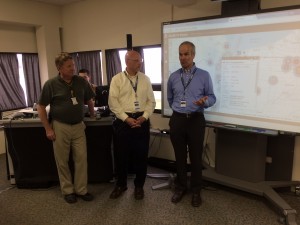
Jeff Friedland (St. Clair County) with CAUSE IV representatives Dennis Gusty and Philip Dawe
It case there was an emergency in the U.S. or Canada that affected both countries, a bi-national experiment has been taking place this week to better prepare emergency officials for a disaster. The two-day exercise was conducted mainly around the Blue Water Bridge, the 2nd busiest crossing between the two countries. Philip Dawe, with the Canadian governments Multi-Agency Crisis Management team says the people are what make this exercise possible. Extensive use of Facebook and Twitter as well as other social media helps. He notes that developing methods of notifying the public during emergencies, as well as testing innovative emergency communications technologies with paramedics as they cross the border, will serve both countries in their emergency planning. Dawe spoke with us at a press conference on the event held at the St. Clair County Emergency Management Offices. It turns out that during the exercise a real alert had been issued from a chemical plant in nearby Corunna, Ontario which highlighted continued questions about emergency notification protocols. St. Clair County Coordinator Jeff Friedland says some of the proper state and provincial notifications were not apparently made but that local alerts had been issued. The plant had an airborne leak that caused no injuries and did not involve St. Clair County. CAUSE IV is the name of the experiment. CAUSE stands for Canada-U.S. Enhanced Resiliency Experiment and this marks the fourth such border crossing involved in the program. During the local exercise this week the first ever bi-national EAS (Emergency Alert System) test between US-Canadian systems was successful. The Canadian EAS system activated the EAS system at Radio First whose family of broadcast stations include WPHM.












